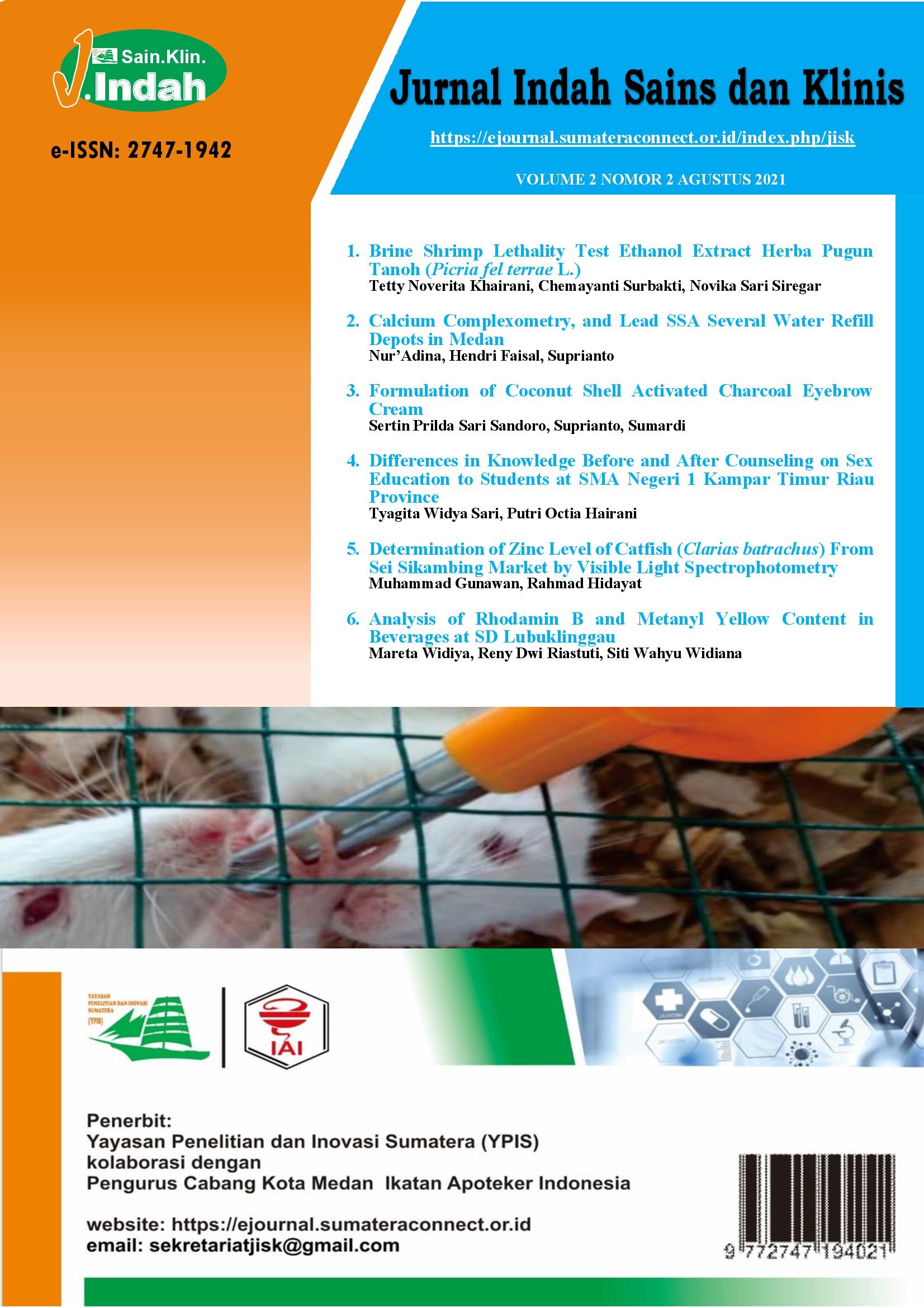Formulation of Coconut Shell Activated Charcoal Eyebrow Cream
DOI:
https://doi.org/10.52622/jisk.v2i2.26Keywords:
Activated charcoal, eyebrow cream, coconut shellAbstract
Eyebrow cream (EC) is one of the decorative cosmetics applied to the eyebrows using a brush for the purpose of giving color and emphasizing the shape of the eyebrows. EC is one of the practical preparations to fill in empty eyebrow hairs. The research was conducted of formulating activated charcoal into EC. The research method includes the formulation and evaluation of EC results from coconut shell activated charcoal at concentrations of activated charcoal 1%, 3%, 5% and 7%. Evaluation includes: organoleptic, homogeneity, irritation and pH of Eyebrow Cream. The organoleptic showed that the color of the preparation at a concentration of 1% -7% was black to dark black, with a cocoa oleum aroma, and a semi-solid texture. The pH of the preparation is 4.5-6.5 with good homogeneity. The preparation did not show irritation to the skin of volunteers. The study provide information that activated charcoal can be formulated into EC preparations. Coconut shell activated charcoal can be formulated in the form of eyebrow cream. The preparation of eyebrow cream does not cause irritation and is safe.
Downloads
References
Kemenkes RI. Permenkes No. 63 Tahun 2013 tentang Perubahan atas Peraturan Menteri Kesehatan Nomor 1175/MENKES/PER/VIII/2010 tentang Izin Produksi Kosmetika. 2013;2008.
Pangaribuan L. Penguasaan Teori Membentuk Alis Menggunakan Sketsa dengan Hasil Praktek Make Up Sehari-Hari Siswa Tata Kecantikan SMK Negeri 8 Medan. Jurnal Darma Agung. 2015;23(2):146–53.
Pambayun GS, Yulianto RYE, Rachimoellah M, Putri EMM. Karbon Aktif dari Arang Aktif Tempurung Kelapa dengan Aktivitator ZnCl₂ dan NaCO₃ sebagai Adsorben untuk Mengurangi Kadar Fenol dalam Air Limbah. Teknik Pomits. 2013;2(1):116–20. http://dx.doi.org/10.12962/j23373539.v2i1.2437
Idrus R, Lapanporo BP, Putra YS. Pengaruh Suhu Aktivasi terhadap Kualitas Karbon Aktif Berbahan Dasar Tempurung Kelapa. Prisma Fisika. 2013;1(1):50–5. http://dx.doi.org/10.26418/pf.v1i1.1422
Mistry N. Guidelines for Formulating Anti-Pollution Products. Cosmetics. 2017;4(4):57. https://doi.org/10.3390/cosmetics4040057
Ulfah T, Sulandjari S. Pengaruh Perbandingan Minyak dan Ampas Biji Kemiri ( Aleuretes Mollucana L. Wiild) terhadap Hasil Jadi Kosmetik Eyebrow Pomade S-1 Pendidikan Tata Rias. Jurnal Tata Rias. 2018;7(2):60–7.
Syamsuni HA. Ilmu Resep. Jakarta: EGC; 2006.
Wasitaatmadja SM. Penuntun Ilmu Kosmetik Medik. Vol. 3, Jakarta: Penerbit Universitas Indonesia. 1997.
Ulfa M, Hardianti B. Eyeshadow dari Liofilisat Mesokarp Buah Naga Merah dan Mesokarp Buah Manggis. Jurnal Farmasi UIN Alauddin Makassar. 2017;4(5):258–69. https://doi.org/10.24252/jurfar.v5i4.4468
Samsul D, Suprianto. Pemanfaatan Bunga Rosella (Hibiscus sabdariffa L.) sebagai Bahan Pewarna pada Lipstik. Jurnal Stikes Helvetia. 2017;IX(17):8–9. http://dx.doi.org/10.5281/zenodo.1246199
Armadany FI, Hasnawati H, Sirait M. Formulasi Sediaan Masker Gel Peel-off Antioksidan dari Ekstrak Sari Tomat (Solanum lycopersicum L. var. cucurbita). Pharmauho. 2013;1(2):29–32. http://dx.doi.org/10.33772/pharmauho.v1i2.3466
Pakpahan A, Suprianto S. Formulasi Sediaan Masker Gel Antioksidan dari Ekstrak Etanol Herbal Selada Air (Nasturtium officinale R. Br). Jurnal Dunia Farmasi. 2018;2(2):84–92. https://doi.org/10.33085/jdf.v2i2.4400
Ardina A, Suprianto S. Formulasi Sabun Cair Antiseptik Ekstrak Etanol Daun Seledri (Apium graveolens L.). Jurnal Dunia Farmasi [Internet]. 2017;2(1):21–8. Available from: https://doi.org/10.33085/jdf.v2i1.4393
Retno T, Fatma L. Buku Pegangan Dasar Kosmetologi. Jakarta: Gramedia Pustaka Utama; 2014.
Departemen Kesehatan RI. Formularium Kosmetika Indonesia. Jakarta: Departemen Kesehatan RI; 1985.
Downloads
Published
Issue
Section
License
Copyright (c) 2024 Jurnal Indah Sains dan Klinis

This work is licensed under a Creative Commons Attribution-NonCommercial-ShareAlike 4.0 International License.









 This work is licensed under a
This work is licensed under a 
